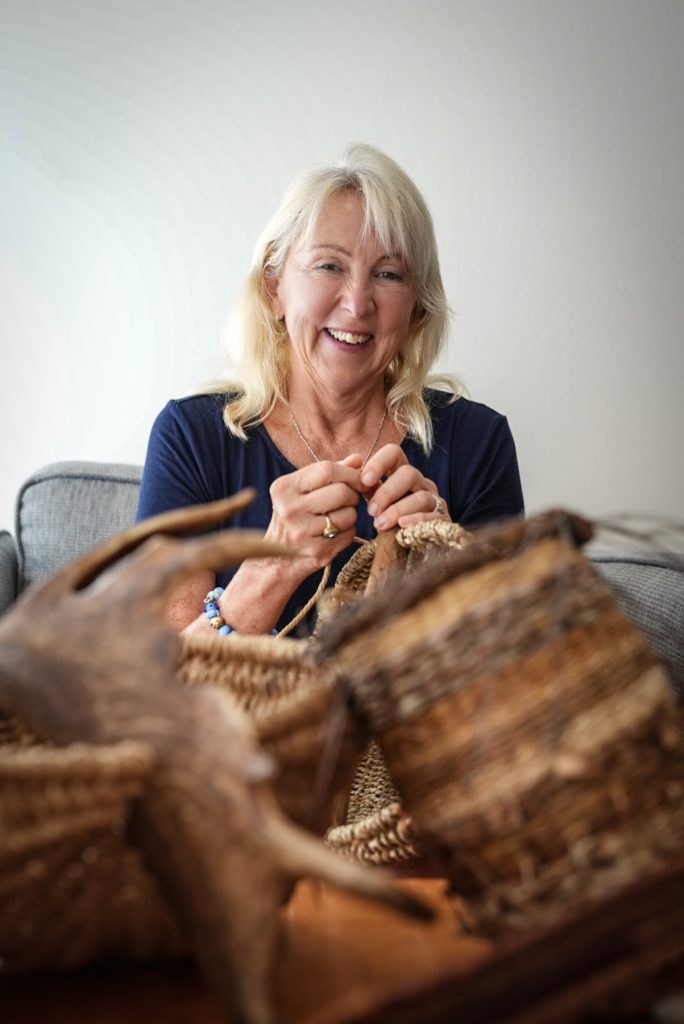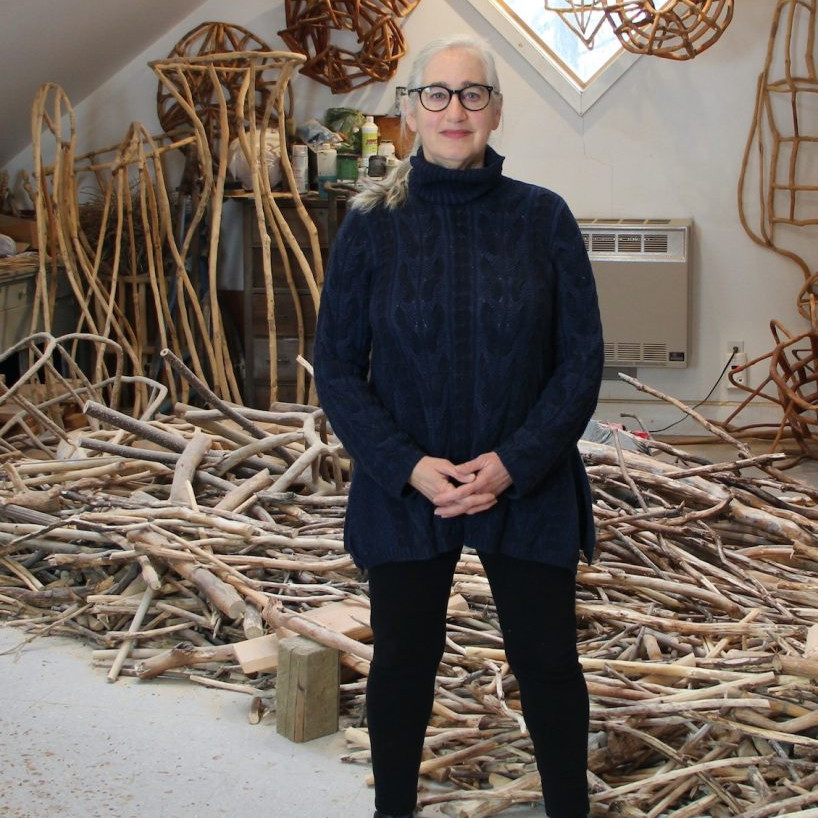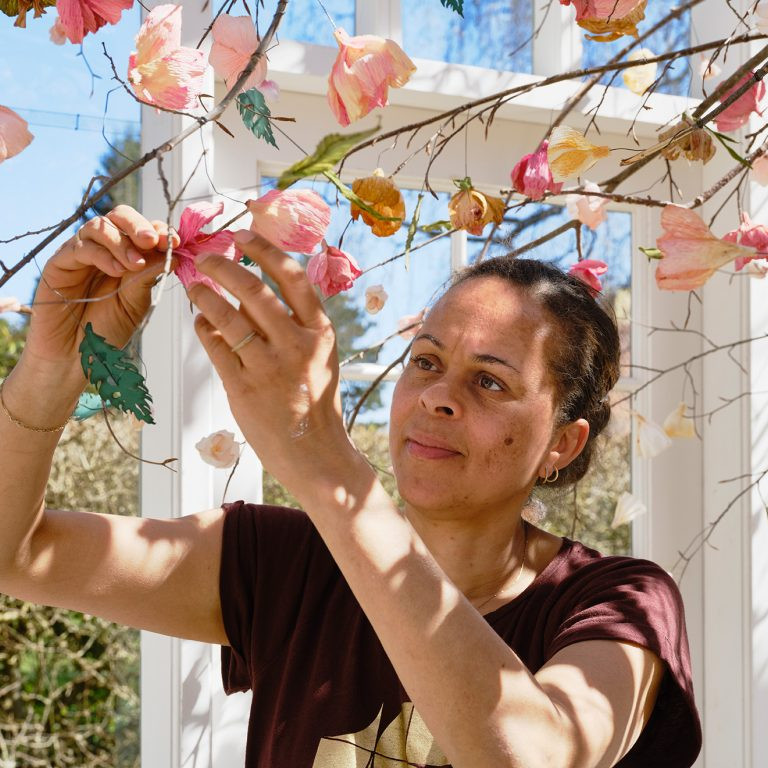Linda Coomber Basket Weaver
Explain what led you to basket weaving?
My interest in basketry and fibre art is a mid-life phenomenon that grew out of a need and into a passion. Having recently moved to the Mid North Coast of NSW, Australia, I acquired some beautiful old wooden chairs with caned seats. The caning was damaged and broken. I searched around for someone to fix them, and a friend introduced me to Helen Beale, one of Australia’s most talented caners and weavers.
Helen declined to fix my chairs but offered to teach me how to do it myself. Out of those caning lessons came basketry, weaving and fibre art.

Black
Why do you source your materials locally rather than using traditional flax?
Every area, indeed, every country, has its traditional weaving materials. In the UK and Europe, it is mostly willow. In native American weaving, sweet grass, pine needles, wicker, spruce root and cedar bark are all used. Anything pliable can be used in basket weaving as long as it is bendable and can form a shape.
I’m still learning and experimenting, and try many different leaves, vines and grasses that grow in my local area, as well as more traditional materials from my area, like Pandanus and Lomandra.

Dracena
Describe the landscape around your studio?
I live on Gumbaynggirr Country on the Coffs Coast of NSW. My area is made up of beaches, headlands, rivers, estuaries, creeks, mountains, and flood plains. It is a diverse and beautiful landscape. Both native and introduced plants grow vigorously in our temperate, humid climate – rich pickings for a scavenger like me!
Collecting seed pods and similar materials is the make of your work. Discuss how they are added to your work.

Clay Base
My weaving is a mix of traditional basket weaving techniques like twining and plaiting, but I also use coiling, where I sew together coils of natural materials using a strong waxed thread. This allows me to add embellishments like stones, shells, and seed pods, which are sewn directly into the work.
Being a scavenger is fine, but where do you store it all?
Yes, storage is a problem. Luckily, I have an airy, dry area under my house, and a very understanding husband!
Mould is my enemy, so once my materials have dried out, I hang them from racks suspended from the ceiling in our garage. That way they stay clean and dry until I need them. Larger pieces are stored in cardboard boxes and paper bags. Air flow is important, so no bags or boxes are ever sealed.
Is this a seasonal activity?
Certainly, in many parts of the world, collecting weaving materials would depend on the season, but in my area, where temperatures are mild all year, I am able to collect all year round.

Driftwood Rush
Expand on the process you take in using local plants to produce a suitable material to weave with.
I’ll use two examples. Lomandra, also known as mat rush, is a perennial clumping plant with long, strappy leaves. They are native to Australia and grow abundantly in my area. I cut handfuls of the leaves close to the base of the plant. Once I’ve harvested the leaves, I think I’ll need, I’ll take them home and spread them out in the direct sun. Within three days, the leaves will curl and dry to around one third of their original width, but they will still retain their green colour. At this stage, I use a sharp needle to split each leaf into thin strips. These strips are quite pliable, and ready for weaving.
The Radiata Pine tree is also very common in my area. It has long needles that when dry, are a lovely red brown colour. The tree sheds its old needles all year round, so you can collect them straight from the ground. After I’ve rinsed and dried them in the sun, I store these in a cardboard box, ready for use.

Serenity Stones
What is the drying time needed?
This varies greatly. Some, like the pine needles, are already dry when I collect them, but most strappy leaves will take a few weeks to dry out completely.
Do you add colour, either natural or manufactured dyes?
I don’t use dyes. I prefer the lovely, earthy colours that that are inherent to each variety of leaf or plant that I use. If I feel the need to add colour, I’ll do it by using coloured waxed thread, particularly in my coiled pieces.

Palm Sheath
A special twist in your work is the use of introduced deer antlers, discuss.
 Antler 1
Antler 1
Deer were introduced into Australia from Europe in the 19th century as game animals. Today, they are feral animals in many areas throughout Australia and cause a variety of environmental problems, unfortunately. Fallow deer are particularly abundant in some areas of NSW. Many people don’t know that deer shed their antlers naturally every year, and then grow a new set. They will often rub up against a tree until the old antlers fall off, so it’s not uncommon to find a set together beside a tree where deer are common.

Antler 2
These naturally shed antlers are beautiful, tactile things. Anywhere in length from 40cm to close to a metre, I have found they make wonderful, dramatic handles to my woven baskets. Their colours are beautiful too. They can range from dark brown to almost white.
Are there any local restrictions on the collecting of plant material?
Aside from it being terribly rude to raid a neighbour’s garden without permission, no, there are no restrictions in my area! I make sure I selectively harvest – I never take a whole plant, just a handful of leaves; after all, I’ll probably want more sometime in the future.
How do you define your work, artwork, or useful artistic objects.
I consider myself a weaver. Weaving is almost as old as human history. Traces of baskets have been found in the Egyptian pyramids, and woven basket liners have left their impressions inside the fragments of ancient pottery.
Baskets and woven materials were needed as containers, clothing, floor coverings, storage and for transport. Almost all cultures used and experimented with the natural materials around them to create woven objects.

In our modern lives, we no longer need to weave our own clothing and floor coverings, but I like the notion of bringing the natural world into our interiors. By beautifying and texturizing our living and working spaces, a statement can be made about valuing artisanal objects, whether considering them as artworks worthy of putting on our walls or as useful objects to be used daily.
Your background in psychology, has it helped with your artistic practice?
If it has, I’m not aware of it!
Take ‘Jacaranda Vase’ and discuss.

Jacaranda trees are very common in my area. Most people will know them for their gorgeous violet coloured flowers, but they also have the most beautiful woody seed pods. I use these seed pods to decorate some of my vessels, and they are particularly lovely around the top of vases. To make the vases suitable to hold fresh flowers, I’ll often build the vessel around a glass insert. That way the vase is a usable and useful piece of art.
The sizes of the vases can vary from 20cm or so to very large pieces that are half a metre in height.
Using locally foraged plants means that I never run out of materials for my pieces.
Comment on the importance of the local artistic community in giving you the opportunity to define your own art.
For the last five years, I have been the gallery manager of our local community art gallery. The Art Space Urunga is entirely staffed and managed by volunteers and supports local established and emerging artists in all mediums. One of the benefits for me has been that through meeting many other artists, I have been able to collaborate with several to combine their skills with mine. For example, I have worked with several potters to design bases for my weaving. A glass artist has made gorgeous luminous glass bowls for me to weave around. Currently, I am working with a local woodworker who is making handles for my pieces from beautiful local timbers. These creative collaborations have brought complementary skillsets that have enhanced my projects.

Vase
You take local workshops, how does your teaching qualifications assist you within the classes?
I have learned through classroom teaching that, no matter what the subject is, it is important to try many different approaches when teaching a skill. Some people respond to what you say, whereas others may learn best by watching and doing. Teaching has also taught me that follow up is vital. Whether I’m teaching someone how to make their own twine or how to make a ribbed basket, I always have notes with detailed instructions and photos for people to take home. You can’t remember everything you’ve learned in a workshop, so handouts can remind you of processes and techniques you may have forgotten.

Palm Platter
How do you extend your students to go beyond the expectations of a basket?
I am constantly surprised by people’s innate creativity. Once the basic methods have been mastered, the resulting baskets from workshop participants are rarely the same. Each individual’s choices of specific materials and how to put them together leads to very different results.
Do you take commissions?
Yes, gladly.
Contact:
Linda Coomber
Details
Linda Coomber
New South Wales, Australia
Deborah Blakeley, Melbourne, Australia
Interview by Deborah Blakeley, May 2024
Images on this page are all rights reserved by Linda Coomber
Think a colleague or friend could benefit from this interview?
Knowledge is one of the biggest assets in any business. So why not forward this on to your friends and colleagues so they too can start taking advantage of the insightful information the artist has given?
Other artists you may be interested in:






